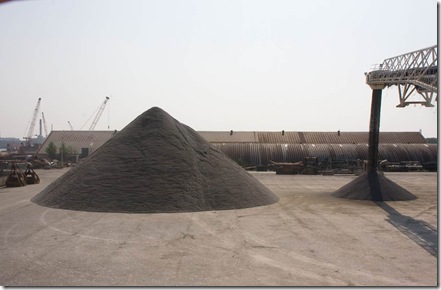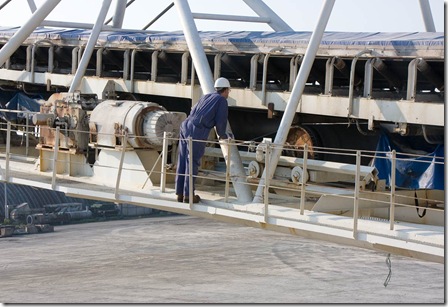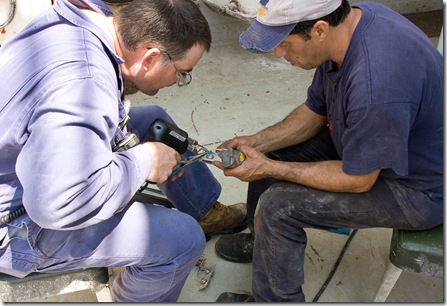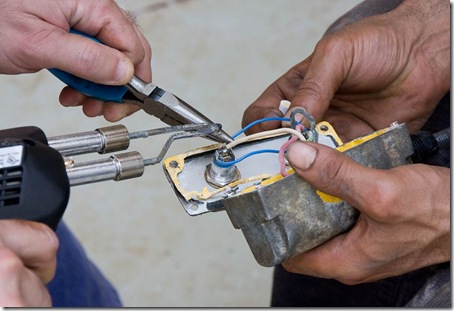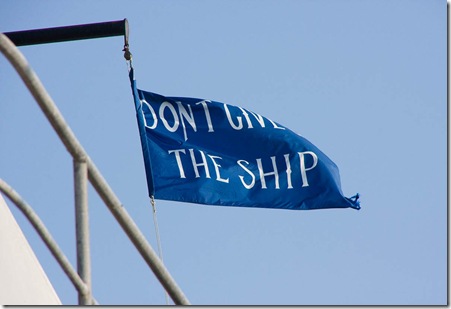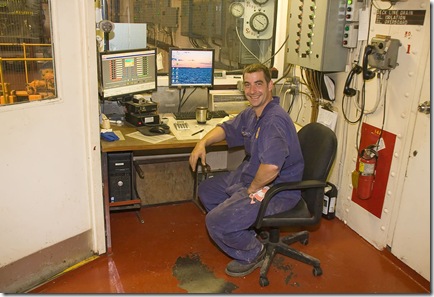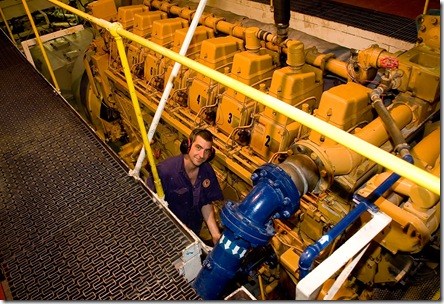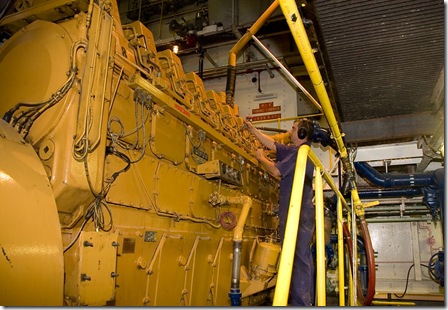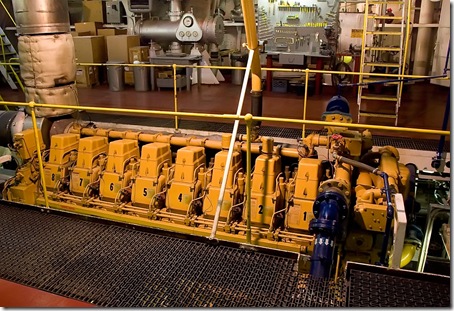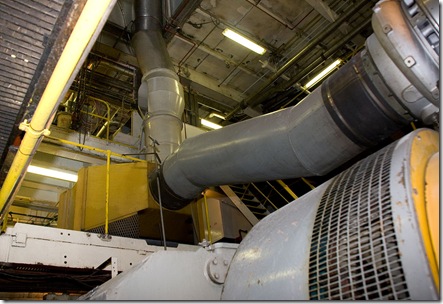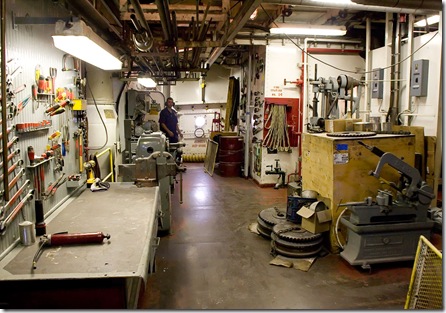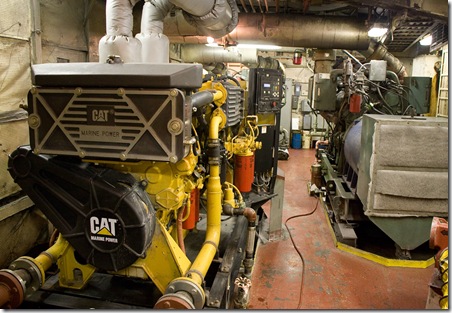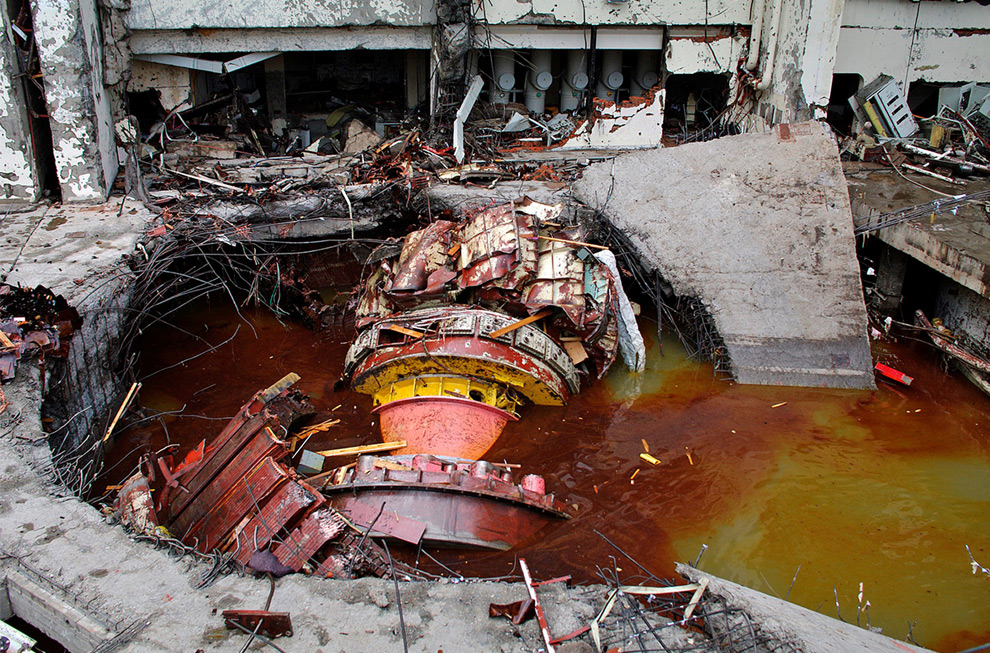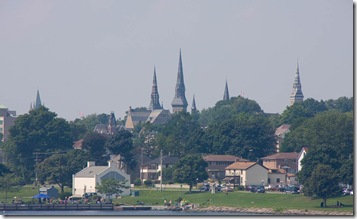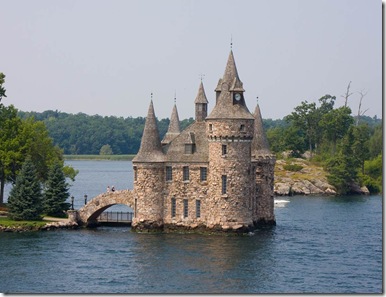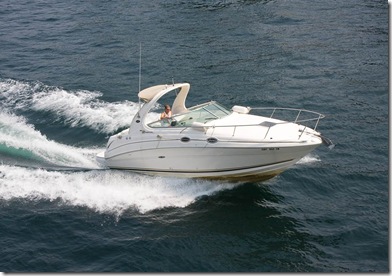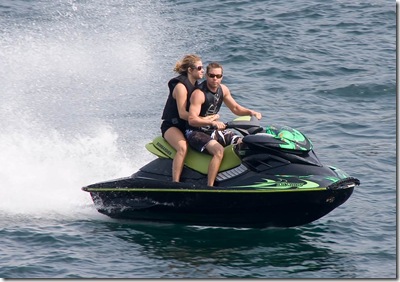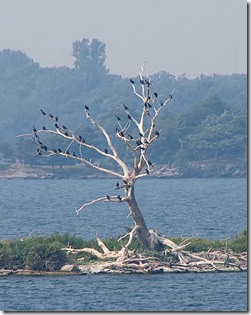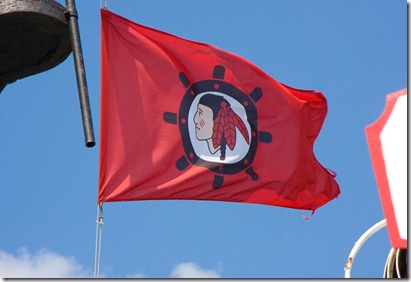The  actual route we took was this: (our route in red)
actual route we took was this: (our route in red)
Lake Ontario from one end to another (east to west) is around 310 km. At the east end, we entered the Saint Lawrence Seaway and from there it is another 125 km to Cardinal, which is situated on the Canadian side of the river, just past the town of Prescott.
 While out on Lake Ontario we deemed ourselves to be in the Caribbean. The air was warm, the water blue with just a few wispy clouds on yonder horizon. The crew told us though that things aren't always this quiet, especially in late October, November when the winds blow. When out in the open, the ship is basically on auto pilot, although 2 of the crew keep a sharp eye out at all times in the wheelroom.
While out on Lake Ontario we deemed ourselves to be in the Caribbean. The air was warm, the water blue with just a few wispy clouds on yonder horizon. The crew told us though that things aren't always this quiet, especially in late October, November when the winds blow. When out in the open, the ship is basically on auto pilot, although 2 of the crew keep a sharp eye out at all times in the wheelroom.
After 12 hours of sailing, we entered the Seaway, just when darkness fell. We then retired to our room and watched a movie on satellite TV, The Poseidon Adventure. By the way, on a trip just before ours, an electrical surge had taken out most of the electronic equipment on board, such as TV's, satellite receivers, stereos etc. Apparently, they all lit up like Christmas trees. The second mate Ralph kindly donated his receiver for the duration of our stay.
 The ship arrived at the corn unloading dock in Cardinal at around 3:00 in the morning, but we had no personal knowledge of that, as we were sound asleep. We did wake up not too much after that though went to motors for the self unloading boom were started, generating a noise so loud we thought a tornado just struck the ship.
The ship arrived at the corn unloading dock in Cardinal at around 3:00 in the morning, but we had no personal knowledge of that, as we were sound asleep. We did wake up not too much after that though went to motors for the self unloading boom were started, generating a noise so loud we thought a tornado just struck the ship.
The ship did not always have the option to unload itself, this contraption was added in the early seventies. Before self unloading was added, the ship had to use the unloading cranes offered by the various ports. Being able to unload itself allows it to visit a far greater range of ports, ports with or without unloading facilities.
 Anyway, when we opened our door to go for yet another excellent breakfast in the galley, we immediately saw a feature that would be with us for the next 36 hours: white corn dust. It took that long to unload the ship, since the accepting hopper on the corn silo could only accommodate a tiny portion of what the unloading boom was actually capable of delivering. Fortunately for us, during the entire time the wind was away from our cabin, so that the actual dust we had to contend with was fairly minimal.
Anyway, when we opened our door to go for yet another excellent breakfast in the galley, we immediately saw a feature that would be with us for the next 36 hours: white corn dust. It took that long to unload the ship, since the accepting hopper on the corn silo could only accommodate a tiny portion of what the unloading boom was actually capable of delivering. Fortunately for us, during the entire time the wind was away from our cabin, so that the actual dust we had to contend with was fairly minimal.
 But the crew! Unbelievable how they were affected by this snow! Yet they all did their jobs throughout the long day, into the night and then into the day again.
But the crew! Unbelievable how they were affected by this snow! Yet they all did their jobs throughout the long day, into the night and then into the day again.
 Since it was another beautiful sunshiny day, we decided to disembark and explore the town of Cardinal. Now, Cardinal is not much of a town, there's the "Boars' Nest" (the local bar) and a few stores and restaurants and that is about it. A one horse town in its classic definition. But folks sure are friendly in Cardinal. Everybody we talked to wanted to talk some more. We met an 82-year-old man originally from Hong Kong who had just driven a van from Vancouver on his own, in order to meet his son who lives in
Since it was another beautiful sunshiny day, we decided to disembark and explore the town of Cardinal. Now, Cardinal is not much of a town, there's the "Boars' Nest" (the local bar) and a few stores and restaurants and that is about it. A one horse town in its classic definition. But folks sure are friendly in Cardinal. Everybody we talked to wanted to talk some more. We met an 82-year-old man originally from Hong Kong who had just driven a van from Vancouver on his own, in order to meet his son who lives in  Kingston. Then we met a fellow from Gatineau, Quebec who was there in his totally custom Western Star mini truck, which was actually a Toyota 4x4 Highlander converted. It had a sleeper, which he used for
Kingston. Then we met a fellow from Gatineau, Quebec who was there in his totally custom Western Star mini truck, which was actually a Toyota 4x4 Highlander converted. It had a sleeper, which he used for  camping, dual fuel tanks, air brakes, air horn, air ride, and dual set of wheels on the back. Superb paint job on top of that. We also talked to some locals, who told us all about the glorious and not so glorious history of the Casco, the corn processing plant.
camping, dual fuel tanks, air brakes, air horn, air ride, and dual set of wheels on the back. Superb paint job on top of that. We also talked to some locals, who told us all about the glorious and not so glorious history of the Casco, the corn processing plant.
All that talking sure makes a man thirsty, so we ended up quaffing a few cool ones at the local (Royal Canadian) Legion, which just so happened to have a beautiful patio overlooking the river.
Next, we made it back to the ship. As we made our way thru security (we had to sign in and out every time we left), the security guard, who, apparently, had already talked to the locals about us, stated that if he would have known about us before he came on shift, he would have come and picked us up to drive us to a beautiful beach just down river near his home. Then, he said, I would have gone back home, changed into my work clothes and come here to work. Talk about friendly...
After supper, with the unloading process going on, we drifted back to the Legion once more to support their financial situation. Slightly inebriated, we were able to negotiate the ladder up to the ship's deck, where the dust created interesting halos around all the lights, the effects of which somewhat amplified by alcohol.
Despite the enormous roar of the self unloading boom's motors, we slept like rocks. The next day, same old thing, more corn dust. Hard working crew. Seagulls. Legion.
thing, more corn dust. Hard working crew. Seagulls. Legion.
Finally, around 7:00 Saturday nite, the unloading finished up. Quickly, the ship was prepared for sailing and at around 8:00 we were moving, heading for Prescott, just up river to take on a load of stone for Hamilton. Now, maneuvering a 600 ft ship in a fairly swift moving river is no child's play, so we watched intently from this wheelhouse as the captain and his crew guided the ship to its new mooring p lace at the Prescott docks. Almost as soon as the ship stopped, the holds were opened and 3 front end loaders started dumping rocks onto stackers, which in turn, dumped their prized possessions into the holds of the ship. This went on throughout the nite, so, looking for a diversion, we decided to call a taxi to take us into the wild town of Prescott. Well, that is a bit of a lie, 2 bars, the first looked like it was a converted old K-mart type store with the lunch counter still in place. Slap a few draft dispensers on that very same counter and you got yourself a bar. Add some very loud music from a not so talented band and the scene is complete. The second establishment, just across the road, was of the strip club variety, so just as high class as the first one. After trying to chat up the woman in the taxi stand place (no go), we headed back to the ship. Loading was rapidly progressing. Too tired to help, despite many requests, we went to bed. Just as we got up again, loading was about to complete.
lace at the Prescott docks. Almost as soon as the ship stopped, the holds were opened and 3 front end loaders started dumping rocks onto stackers, which in turn, dumped their prized possessions into the holds of the ship. This went on throughout the nite, so, looking for a diversion, we decided to call a taxi to take us into the wild town of Prescott. Well, that is a bit of a lie, 2 bars, the first looked like it was a converted old K-mart type store with the lunch counter still in place. Slap a few draft dispensers on that very same counter and you got yourself a bar. Add some very loud music from a not so talented band and the scene is complete. The second establishment, just across the road, was of the strip club variety, so just as high class as the first one. After trying to chat up the woman in the taxi stand place (no go), we headed back to the ship. Loading was rapidly progressing. Too tired to help, despite many requests, we went to bed. Just as we got up again, loading was about to complete.

 To be continued...
To be continued...

